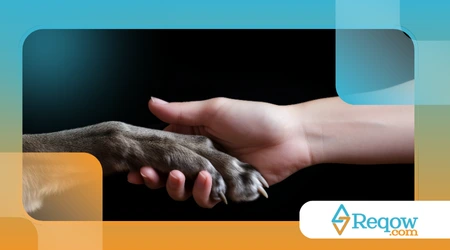Can dogs identify good and bad people just by smell? Studies show that they can.

Identify good and bad people just by smellA dog's nose is a marvel of evolution, surpassing ours by orders of magnitude.
Advertisements
They have millions of olfactory receptors, allowing them to detect odors in minute concentrations.
This heightened olfactory ability isn't limited to simple scents. Dogs are capable of discerning subtle nuances that escape human perception.
For them, the world is a complex carpet of scents, each telling a unique and detailed story.
This feature is widely exploited in various areas, from disease detection to the search for missing people.
Advertisements
Canine olfactory sensitivity is a powerful tool, shaped by millennia of evolution and coexistence with humans.
It is through this primary sense that they interpret much of the environment around them, forming their perceptions.
Human Chemistry and Canine Perception
Identify good and bad people just by smellOur bodies exude a myriad of volatile chemical compounds. These, invisible to us, are a rich source of information for dogs.
Stress, fear, happiness, and even certain health conditions alter our olfactory profile. Dogs are experts at deciphering these signals.
A study by the University of Naples Federico II, published in the journal Animal Cognition in 2017, revealed remarkable insights.
Research has shown that dogs can differentiate the odors of humans who have experienced different emotional states.
Read more: Interesting Facts About Dogs' Sense of Smell
Specifically, they were able to distinguish between sweat samples from individuals in stressful and relaxed situations.
This suggests that human emotions produce “chemical signatures” that are recognizable to dogs.
It's as if each emotional state emits a particular fragrance to the canine world.
These chemical changes are part of what dogs interpret when interacting with us, forming their impressions.
Beyond Smell: Canine Behavioral Reading
Although smell is paramount, canine communication is multifaceted. They are keen observers of body language.
Small gestures, tone of voice and facial expressions are processed in conjunction with olfactory information.
A dog doesn't judge by smell alone, but by a combination of sensory and behavioral factors.
They notice inconsistencies between what someone smells like and how that person acts.
For example, a forced smile may not fool a dog, who reads muscle tension along with the olfactory profile.
This ability to integrate different types of data makes them astute judges of human character.
Dogs' social intelligence is underestimated by many, but it is crucial for their interaction in our world.
They build a complex map of each individual, to identify good or bad people by their smell. This is a centerpiece.

The Protective Instinct and Threat Aversion
Dogs have an innate protective instinct. They are attuned to detecting threats, both to themselves and their owners.
A smell that is neutral to us can signal imminent danger to a dog.
The release of stress hormones in humans, such as cortisol, can be detected by dogs.
This detection can activate your warning system, leading to cautious reactions or even defensive aggression.
It is nature equipping them to discern potential risks in their social environment.
++ How to identify pain in pets that don't show visible symptoms
Therefore, a dog often reacts negatively to a person for no apparent reason to us.
He may be picking up on a sign of distrust that our sense of smell can't pick up.
This perception is a survival mechanism, developed over millennia of domestication.
Real Examples of Canine Perception
Imagine this: a new neighbor moves in next door. He smiles, waves, and seems friendly.
However, the family dog, a usually docile golden retriever, growls and backs away whenever the neighbor approaches.
The owners are confused, as the neighbor is apparently harmless.
Months later, they discover that their neighbor has a history of aggressive behavior in his former community.
The dog, with its sensitivity, may have sensed tension or an olfactory profile of dishonesty.
Another example: a child who is afraid of dogs tries to approach a Labrador, but trembles slightly and holds his breath.
The Labrador, who loves children, begins barking and moving away, despite there being no threatening action.
It senses the child's fear through chemical and postural signals, reacting to the perceived anxiety.
The dog's reaction is not one of aversion to the child itself, but to the emotional state it exudes.
It's as if the child's fear is a pungent smell to the animal, generating a cautious response.
The Nuance of Canine “Goodness” and “Badness”
It is important to emphasize that dogs do not operate in moral categories such as “good” or “bad” in the human sense.
They interpret signals of threat, discomfort, friendliness, or vulnerability.
To a dog, “bad” can mean unpredictable, scary, or potentially dangerous.
“Good” can be interpreted as safe, calm and predictable, generating trust.
Still on this subject: How to deal with jealousy between pets and children at home
Your perception is based on how interacting with the person affects your well-being and safety.
The dog's response is pragmatic, focused on its own safety and that of its social group.
They don't judge character, but predict outcomes based on their olfactory and behavioral database.
It is an interpretation of the world focused on survival and comfort, not on complex ethical concepts.
Smell and Health: A Deep Connection
Dogs are remarkable at detecting diseases that alter the body's chemical profile. This reinforces their ability to identify good and bad people just by smell in a broader context.
They can sniff out conditions like cancer, diabetes, and epilepsy even before a medical diagnosis.
This ability suggests that the human body emits chemical “signatures” for a variety of internal states.
If dogs detect disease, it is plausible that they also detect intense and consistent emotional states.
The chemistry of fear, for example, is quite distinct from the chemistry of calm and confidence.
These differences are sensed by dogs' highly sensitive olfactory receptors.
It is proof of the sophistication of its olfactory system and its connection with the human universe.
The detection capacity is not limited to pathologies, but extends to psychological and emotional states.

The Human-Canine Relationship: A Bond of Trust
Mutual trust between dogs and humans is built in part on this subtle communication.
When a dog reacts to a person, it is worth observing and reflecting on the possible reasons.
It doesn't mean the person is "bad," but that the dog noticed something that deserves attention.
This canine perception can be a warning sign of suspicions or anxieties that are not obvious to us.
It is an extra layer of information, provided by a being that reads the world differently.
Valuing this canine perception can strengthen our security and understanding of the social environment.
The ability of dogs to identify good and bad people just by smell is, therefore, a manifestation of his intelligence.
It is not a moral judgment, but a reading of the environment that deserves our respect and consideration.
A striking statistic illustrates the olfactory superiority of dogs: they have around 300 million olfactory receptors.
In contrast, humans have only about 6 million.
This massive difference is what allows dogs to detect odors at concentrations that are millions of times lower than what we can perceive.
Human vs. Canine Olfactory Comparison
| Olfactory Characteristics | Humans | Dogs |
| Olfactory Receptors (approximate) | 6 million | 300 million |
| Olfactory Epithelium Area (approximate) | 5 cm² | 150 cm² |
| Functioning Olfactory Genes | ~400 | ~1200 |
| Odor Detection Capability | Limited | Exceptional |
The Canine Nose as a Supercomputer
Think of a dog's nose as a biological supercomputer, while the human nose is a simple calculator.
The (human) calculator can add and subtract, detecting obvious smells like coffee or gasoline.
The (canine) supercomputer, on the other hand, can process complex algorithms, analyzing thousands of chemical components in real time, detecting subtleties such as a person's stress or the onset of a disease.
To identify good and bad people just by smell, the dog doesn't just “smell,” it “analyzes data” with a depth that is beyond our immediate understanding.
A More Complete View
Dogs truly possess an extraordinary ability to perceive, going beyond what our senses can capture.
The ability to identify good and bad people just by smell It is not a myth, but a complex interaction of their keen sense of smell with their social intelligence.
They read our body chemistry and combine it with body language and behavior to form a detailed picture.
Respecting this canine perception means recognizing the intelligence and sensitivity of these animals we love so much. Are we paying enough attention to what they tell us?
Frequently Asked Questions
Can dogs really “know” if a person is good or bad?
Not in a human moral sense.
They detect signs of stress, fear, aggression, or calm through smell and body language, which leads them to react protectively or in a friendly way.
How do dogs detect human emotions by scent?
Emotions alter the chemical composition of sweat and other bodily secretions.
Dogs have extremely sensitive olfactory receptors that detect these changes, interpreting them as signs of different emotional states.
My dog growls at some people. Does that mean they're dangerous?
Not necessarily. It could mean your dog has detected a sign of anxiety, nervousness, or unpredictability in the person.
Growling can be a cautious reaction or a warning, not a judgment of “evil.”
Is there training for dogs to learn to identify bad people?
There's no specific training for "bad people." Training focuses on reinforcing protective behaviors and threat detection.
The ability to discern is innate and honed by the dog's experience.
Can I completely trust my dog's reaction to someone?
It is wise to consider your dog's reaction as a warning or additional information.
Consider the context, the person's body language, and other factors. The dog's reaction is a guide, not a definitive judgment.
